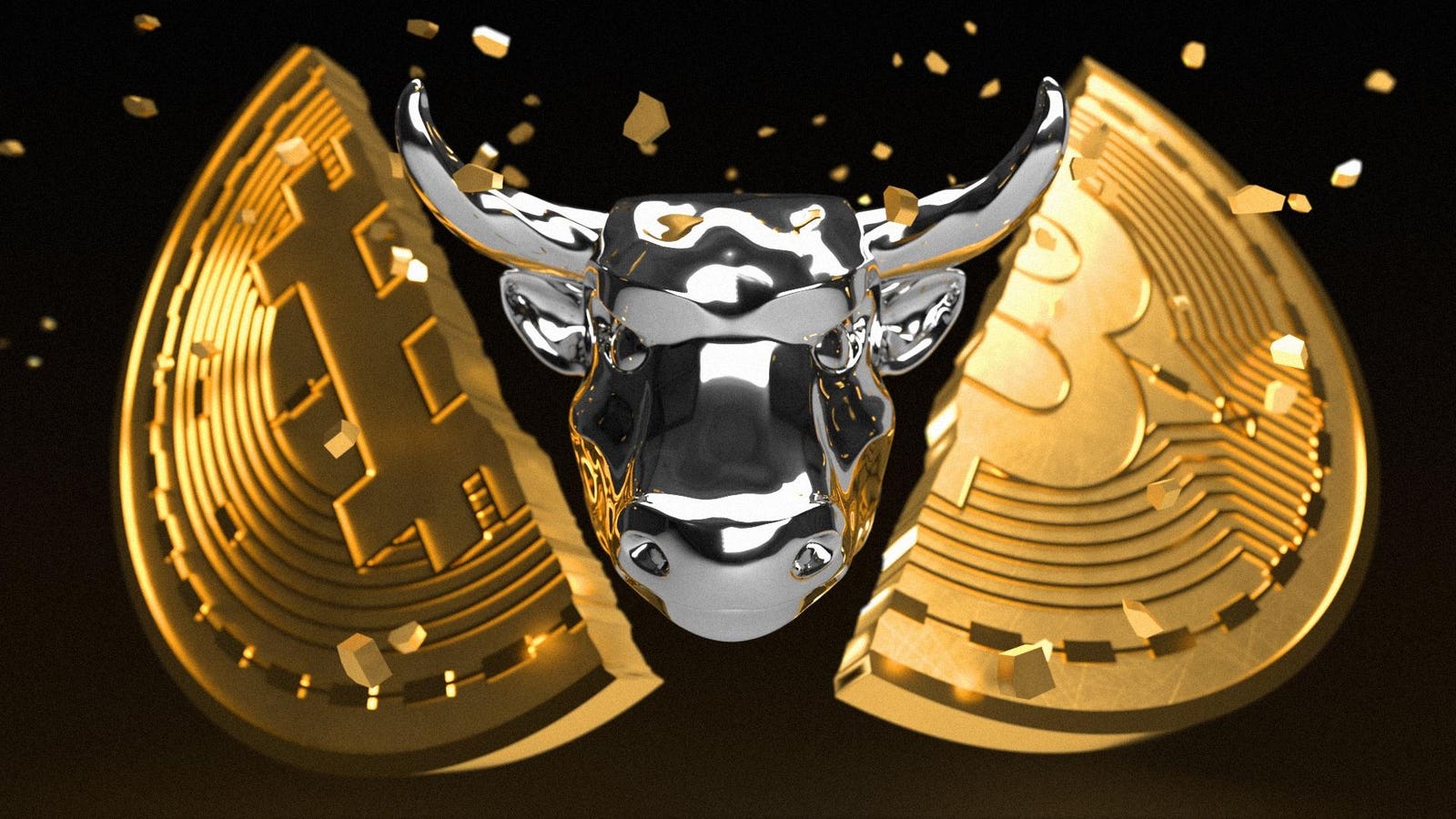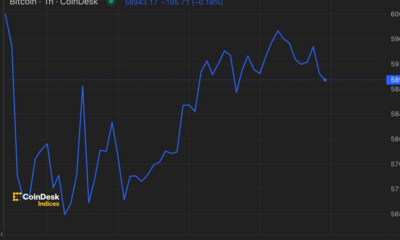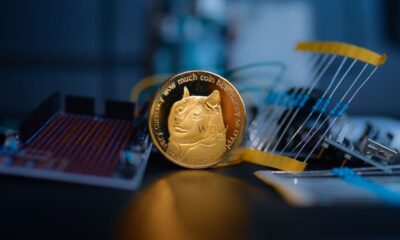News
Best Buys For The Bitcoin Halving

Bitcoin is up 44% so far this year. Its halving could accelerate this trend and spread the gains to other stocks and tokens. Some crypto miners may face a difficult road ahead.
Nina Bambysheva, Forbes Staff
Bitcoin’s much anticipated halving will occur tomorrow at approximately 9:30 pm EST. What’s a halving? It’s a technical change initially written into the source code of bitcoin by Satoshi Nakamoto, the token’s pseudonymous creator, which mandates a gradual reduction in the growth of its supply. After tomorrow only 3.125 bitcoin will be awarded to miners who solve the complicated mathematical problems (called proof of work) necessary to add a new block to the Bitcoin blockchain. This occurs every 10 minutes. Before the halving miners made double that amount. The halving is part of bitcoin’s answer to the risk of runaway inflation that some currencies face when central banks debase their money. Bitcoin’s maximum total supply is limited to 21 million coins. There are roughly 19.7 million outstanding today. Because of halvings, the last bitcoin is projected to be mined in the year 2140.
For investors, halvings, which occur every four years, have proven to be bullish. When the first halving occurred in 2012, bitcoin’s price was a mere $12 or so. Within less than a year it had risen to more than $100. During its second halving in 2016, bitcoin was selling at $650. In 2017, it surged to nearly $20,000 as the crypto initial coin offering bubble inflated. The asset was trading under $8,000 before the last halving in 2020, today it is worth $62,000.
The easiest way to play the halving today is to simply buy the cryptocurrency through an intermediary like Robinhood or Coinbase, or buy shares in one of the 11 new SEC-approved spot bitcoin exchange-traded funds being offered from the likes of BlackRock, Fidelity, Invesco and Ark Invest. But there are other ways to play a post-halving rise in the price of crypto’s seminal currency.
STOCKS
What’s good for bitcoin is often great for bitcoin miners. Bitcoin miners don’t move any dirt, they instead run banks of energy-slurping servers in an attempt to solve the pointless mathematical equations necessary to create new bitcoin blocks. Since the last halving in May 2020, bitcoin is up 641%. The three largest publicly traded miners, Marathon Digital Holdings (MARA), CleanSpark (CLSK) and Riot Platforms (RIOT), are up 1,821%, 613%, and 407%, respectively.
Over the long term, the miners have performed exceptionally, however year-to-date mining stocks have turned in abysmal performance (see chart below). The exception is CleanSpark, a miner based in Henderson, Nevada with nine mining facilities mostly in the Southeast. Its stock is up around 33%, though it still trails bitcoin, which is up 44% so far this year.
Why are bitcoin mining stocks ailing? Because post-halving, miners stand to make half as much as they were making before, at least until the price of bitcoin doubles. They also face new competition from spot bitcoin ETFs which have amassed $59 billion in assets since January. In the past, investors have used shares of bitcoin miners as SEC-regulated proxies for bitcoin. Now they don’t have to.
Now may be a good time to selectively invest in the beleaguered mining stocks: the most efficient will come through the halving stronger and will ultimately benefit as bitcoin’s price climbs.
“Miners are not going to be making as much money, but they, at least the bigger ones, have done enough over the last year to prepare for the revenue shock,” says Colin Harper, head of content and research at bitcoin mining services firm Luxor Technologies.
“The game is no longer about being on the low end of the cost curve. A miner must be on the low end of the cost curve and have access to capital at a low cost,” says Amanda Fabiano, founder of mining-focused Fabiano Consulting. “As block subsidies become scarcer, the importance of strategy and economies of scale intensifies, leading to an increased activity in mergers and acquisitions. The landscape of miners, both public and private, might look very different in one year’s time.”
LARGE BITCOIN MINERS
Miners like Marathon, CleanSpark, Riot, and Bitdeer have raised over $1 billion in equity last year in an effort to fund new technology that will increase the efficiency and speed of their “fleets” of computers. Additionally, “large miners invested not just in new machines but new facilities to expand their megawatt capacity,” adds Harper. “Miners are going to have to be more vertically integrated to survive post-halving,” he warns. This means controlling not only the machines that process bitcoin transactions but also owning power sources to lower the cost of electricity.
Marathon, the largest miner by computing power, has recently acquired three mining sites in Texas and Nebraska where electricity is cheap. Previously, it had largely relied on computers of competitors like Hut 8, bearing higher operating costs than those of its peers. In February, rival CleanSpark also announced the acquisition of three new facilities in Mississippi to diversify its geographical presence beyond Georgia and New York.
Bitdeer is taking vertical integration to a whole new level. Last month, the Singapore-based miner with $369 million in revenues, announced the testing of its first cryptocurrency mining chip, SEAL01, which it plans to integrate into the company’s new SEALMINER A1 mining machines. The new chips are designed to improve performance while minimizing power consumption. The production of mining rigs may not only open up a fresh source of income for Bitdeer but also allow the company to bypass the need to buy rigs from external suppliers for its own operations (most miners are dependent on the industry’s duopoly of Chinese manufacturers, Bitmain and MicroBT). This could substantially reduce their capital expenditures, notes Mark Palmer, senior equity research analyst at The Benchmark Company. Bitdeer was spun off from Bitmain in January 2021. Its new CEO Jihan Wu cofounded Bitmain and had served as its chief executive before the transition. The company intends to install the new miners at its data centers in Rockdale, Texas and Norway by the year’s end.
Speculative investors may want to consider an investment in Core Scientific, which returned to the public market in January after emerging from bankruptcy. Core’s stock is down 20.9% since its return on Nasdaq on January 24 but Kevin Dede, an analyst at H.C. Wainright, rates the stock a buy, saying, “We expect the company to prove its mettle over time. With only $71 million in debt to service in 2024, we think Core is positioned to streamline its operations further while generating cash in the buoyant mining environment.”
Among miners, Miami’s Hut 8 is even more speculative than Core Scientific, and probably should be avoided. The company has been under attack by short-seller J Capital Research, which released a report in January critical of Hut 8’s merger with US Bitcoin Corp. (USBTC). Shortly after the negative report surfaced Hut 8 appointed new CEO Asher Genoot, cofounder of USBTC, which builds and operates data centers securing the bitcoin network. Genoot was featured in Forbes’ 30 Under 30 2024 list.
Hut 8’s stock lost 23% after J Capital’s report called the miner’s merger with US Bitcoin Corp. an “over-levered pump-and-dump” scheme and alleged questionable undisclosed stock ownership and low operational efficiency. In response, Hut 8 issued a statement calling J Capital “a deliberate attempt to spread misinformation about Hut 8, its operations, finances, management practices, and key executives.”
The ultimate question is, “Who is going to run the best race in terms of getting to scale in the most efficient manner possible by adding electric capacity, increasing the efficiency of their fleets, adding next-generation mining machines, and ultimately positioning themselves to withstand downturns in the future,” asks Palmer.
Aside from crypto mining stocks, Virginia-based software company MicroStrategy (MSTR) is well-positioned to benefit from the halving if the price appreciation that followed the previous halvings reoccurs. MicroStrategy’s shares are up 83% this year, roughly double bitcoin’s 44% gain. “The key to MSTR’s outperformance versus bitcoin has been its use of leverage to acquire bitcoin as a result of its opportunistic tapping of the capital markets,” says Palmer. Just last month, the software maker conducted two convertible bond offerings collectively worth $1.4 billion. Much of the proceeds will go toward buying more bitcoin.
“In as much as MicroStrategy is a levered play on bitcoin, we view it as well positioned to continue to outperform especially if history repeats and a powerful rally follows the fourth bitcoin halving as the first three halvings had been,” notes Palmer.
MicroStrategy may be a turbocharged play on bitcoin, but it is also a risky one. Its market capitalization currently sits at $26 billion but the company holds 214,246 BTC worth about $14.6 billion at current prices—a premium of more than 70%. Dede from H.C. Wainwright thinks the stock is overvalued: “It would be a different story if there wasn’t such a huge premium,” he says.
Another way to play bitcoin’s rise is to buy shares in Coinbase, the publicly traded San Francisco-based pure-play cryptocurrency exchange. Oppenheimer and Keefe, Bruyette & Woods raised their price targets on Coinbase ahead of the halving to $276 and $230 respectively. The stock currently trades for $214.
TOKENS
If halvings tend to be good for bitcoin prices, it stands to reason that other cryptocurrencies will benefit as well—especially those related to bitcoin.
“There exists a large, untapped pool of capital within the bitcoin ecosystem that remains dormant, and surprisingly few listed assets that traders can use to gain exposure to the narrative. Should capital begin to rotate into the bitcoin ecosystem, tokens like rune, stx, and ordi could benefit significantly and outperform,” wrote Jake Ostrovskis, OTC Trader at algorithmic trading firm Wintermute, in comments shared with Forbes.
Rune is the native token of THORChain, a decentralized exchange enabling token swaps across different blockchains. It could be a beneficiary of bitcoin’s rise, though last Thursday it was hacked for $4.9 million. There are other platforms that act as bridges between blockchains similarly to THORChain, such as Wormhole and LayerZero, but they do not have tokens that investors can use to speculate.
Stx is the native token of the Stacks protocol, which enables the creation of decentralized applications on top of Bitcoin similar to Ethereum. The token gained 51% this year thanks to the excitement about the upcoming upgrade to Stacks, which is expected to boost transaction speed on the network. However, the blockchain has been modestly used, according to Forbes’ recent analysis.
Ordi, a meme token based on the Ordinals protocol, famous for enabling the creation of NFTs on the Bitcoin blockchain, surged from its March 2023 inception to a market cap of $1.6 billion by the end of 2023, but is down 45% since the beginning of the year. Ordinals creator Casey Rodarmor said he will soon launch a new token standard for Bitcoin called Runes (separate from THORChain’s rune) that seeks to give users a more efficient way of creating fungible tokens, which will live on top of the Bitcoin blockchain. Think, a better way to create new cryptocurrencies, utility and reward tokens.
But Rodamor himself is skeptical. “Fungible tokens are 99.9% scams and memes,” he wrote in his blog last year. “However, they don’t appear to be going away any time soon, similar to the way in which casinos don’t appear to be going away any time soon. Creating a good fungible token protocol for Bitcoin might bring significant transaction fee revenue, developer mindshare, and users.”
Runes’ launch is expected to co-occur with the halving. Watch out for a rush of new tokens that will likely utilize the new standard. Traders are also likely to pile into meme coins on the Bitcoin network, wrote Bartosz Lipiński, CEO of Cube.Exchange.
TradingView
There are more reasons to keep an eye on Runes. “It is expanding the narrative of bitcoin from the digital gold/store of value to this value asset platform and ecosystem with many apps and other native assets being built on top of it,” says Fabiano. “None of that existed at the time of the last halving.” If Runes is successful, Fabiano believes it could “kick off a market frenzy in terms of transaction fees”—as new tokens get created and traded, miners stand to collect fees from those transactions. Says Fabiano, “Anyone not paying attention to this is missing the bigger picture.”
Editor’s Note: The previous version of the story named Hut 8’s former headquarters in Toronto. The company is now based in Miami.
MORE FROM FORBES
ForbesHow $30 Plushy Penguins Helped An NFT Company Survive Crypto WinterBy Maria Gracia Santillana LinaresForbesThe Rise Of Crypto’s Billion Dollar ZombiesBy Steven EhrlichForbesHow A Bitcoin Supply Crunch Could Push The Price To $100,000By Charles Lloyd Bovaird IIForbesMeet The New AI-Robot BillionaireBy Kerry A. DolanForbesFive Undervalued Sports Stocks To Buy And HoldBy Mike Ozanian
Fuente
News
Ether Drops Further After ETF Launch

Key points
- Spot ether ETFs began trading in the U.S. today, with the funds initially having more than $10 billion in collective assets under management.
- Analysts expect the launch of spot ether ETFs to have a net negative impact on the underlying price of ether in the near term, due to expected outflows from the pre-existing Grayscale Ethereum Trust.
- Spot Bitcoin ETFs continue to see strong inflows, with BlackRock’s IBIT alone seeing more than $500 million in inflows on Monday.
- Franklin Templeton, a spot ETF issuer on bitcoin and ether, has invested in a project that intends to bring Ethereum technology to Bitcoin.
Nine-point ether exchange-traded funds (ETFs)) started trading on the stock market on Tuesday, but all the optimism ahead of their approval did not translate into gains for the cryptocurrency markets.
Ether (ETH), the native cryptocurrency of the Ethereum blockchain, dropped less than 1% around the $3,400 level as of 1:30 PM ET, while Bitcoin (BTC) fell more than 2% to around $66,000.
Ether ETFs’ Debut Isn’t as Flashy as Bitcoin ETFs’
Spot ether ETFs began trading at just over $10 billion assets under management (AUM)), according to Bloomberg Intelligence analyst James Seyffart, most of that money is in the current Grayscale Ethereum Trust (ETHE) which has now been converted into an ETF.
“In the long term, Grayscale will simultaneously have the highest and lowest fees in the market. The asset manager’s decision to keep its ETHE fee at 2.5% could lead to outflows from the fund,” Kaiko Research said in a note on Monday.
Outflows from ETHE, if they occur, would be similar to those faced by Grayscale’s Bitcoin Trust (GBTC) after spot bitcoin ETFs began trading in January of this year, most likely due to high fees for the two original funds. Grayscale’s existing fund charges 2.5% fees, while a new “mini” ether ETF will charge 0.15% and commissions for other ETFs are set at 0.25% or less.
Such outflows could impact the price of ether and market sentiment.
“There could be a pullback shortly after the launch of Ethereum spot ETFs, i.e. outflows from Grayscale Ether Trust could dampen market sentiment in the short term,” Jupiter Zheng, a partner at Hashkey Capital’s liquid fund, told The Block.
But Grayscale remains optimistic.
“Compared to the splashy debut of spot bitcoin ETPs in January, the launch of ethereum ETPs has been relatively muted,” said Zach Pandl, Grayscale’s head of research, adding that investors may be “undervaluing” ether ETFs that are “coming to the U.S. market in tandem with a shift in U.S. cryptocurrency policy and the adoption of tokenization by major financial institutions.”
Bitcoin ETF Inflows Continue to Rise
As for bitcoin, there is clearly no lack of demand for spot ETFs, such as BlackRock’s iShares Bitcoin Trust (IBITS) recorded its sixth-largest day of inflows in its short history on Monday, at $526.7 million, according to data from Farside Investors. Daily inflows for the overall spot bitcoin ETF market also hit their highest level since June 5.
In particular, asset manager Franklin Templeton, which has issued both bitcoin and ether ETFs, appears to have decided to cover its back when it comes to Ethereum by investing in Bitlayer, a way to implement Ethereum technology on a second-layer Bitcoin network, according to CoinDesk.
News
Spot Ether ETFs Start Trading Today: Here’s What You Need to Know

Key points
- Spot ether ETFs will begin trading on U.S. exchanges on Tuesday. Nine ETFs will trade on Cboe BZX, Nasdaq and NYSE Arca.
- Ether ETFs offer investors exposure to the price of their underlying assets.
- Commissions on these new ETFs generally range from 0.15% to 0.25%.
- These ETFs do not provide exposure to Ethereum staking.
The U.S. Securities and Exchange Commission (SEC) has officially approved nine ether spots (ETH)exchange-traded funds (ETFs) for trading on U.S. exchanges. Trading for these new cryptocurrency investment vehicles begins today. Here’s everything you need to know.
What new ether ETFs are starting to trade today?
Spot ether ETFs starting trading today can be found at Quotation, NYSE Arkand Cboe BZX. Here’s a breakdown of each ETF you can find on these three exchanges, along with the fund tickers:
Cboe BZX will list the Invesco Galaxy Ethereum ETF (QETH), the 21Shares Core Ethereum ETF (CETH), the Fidelity Ethereum Fund (FETH), the Franklin Ethereum ETF (EZET) and the VanEck Ethereum ETF (ETHV).
Nasdaq will have the iShares Ethereum Trust ETF (ETHA) created by BlackRock, which also operates the largest spot bitcoin ETF under the ticker IBIT.
NYSE Arca will list the Bitwise Ethereum ETF (ETHW) and the Grayscale Ethereum Trust (ETHE). The Grayscale Ethereum Mini Trust (ETH), which will begin trading on the same exchange.
How does an ether ETF work?
Spot ether ETFs are intended to offer exposure to the price of ether held by the funds. Ether is the underlying cryptocurrency of the Ethereal network, the second largest crypto network by market capitalization.
ETF buyers are buying shares of funds that hold ether on behalf of their shareholders. Different spot ether ETFs use different data sources when it comes to setting the price of ether. Grayscale Ethereum Trust, for example, uses the CoinDesk Ether Price Index.
None of the ETFs launching today include pointed etherwhich represents a potential opportunity cost associated with choosing an ETF over other options such as self-custody or a traditional cryptocurrency exchange.
Ether staking currently has an annual return of 3.32%, according to the Compass Staking Yield Reference Index Ethereum. However, it is possible that the SEC will eventually approve Ether staking held by ETFs.
How can I trade Ether ETFs?
ETFs can simplify the trading process for investors. In the case of cryptocurrencies, instead of taking full custody of the ether and taking care of your own private keysSpot ether ETFs allow investors to purchase the cryptocurrency underlying the Ethereum network through traditional brokerage accounts.
Today, not all brokers may offer their clients spot ETFs on cryptocurrencies.
What are the fees for ether ETFs?
The fees associated with each individual spot ether ETF were previously revealed In the S-1 OR S-3 (depending on the specific ETF) deposit associated with the offerings. These fees are 0.25% or less for all but one.
The Grayscale Ethereum Trust, which converts to an ETF, has a fee of 2.5%. The Grayscale Mini Ethereum Trust has the lowest fee at 0.15%. These fees are charged on an annual basis for the provider’s management of the fund and are in line with what was previously seen with spot bitcoin ETFs.
Brokers may also charge their own fees for cryptocurrency trading.
News
Kamala Harris Odds Surge Amid $81M Fundraise. What Does It Mean for Bitcoin and Cryptocurrencies?

Market odds and memecoins related to US Vice President Kamala Harris have soared as the latest round of donations tied to the Democratic campaign raised $81 million in 24 hours, bolstering sentiment among some traders.
The odds of Harris being declared the Democratic nominee have risen further to 90% on cryptocurrency betting app Polymarket, up from 80% on Monday and setting a new high.
Previously, in early July, bettors were only betting on 8%, but that changed on Saturday when incumbent President Joe Biden announced he would no longer run in the November election. Biden then approved Harris as a candidate.
Polymarket traders placed $28.6 million in bets in favor of Harris, the data showsThe second favorite is Michelle Obama.
Somewhere else, Memecoin KAMA based on Solanaa political meme token modeled after Harris, has jumped 62% to set a new all-time high of 2 cents at a market cap of $27 million. The token is up a whopping 4,000% from its June 18 low of $0.00061, buoyed primarily by the possibility of Harris becoming president.
As such, Harris has yet to publicly comment on cryptocurrencies or her strategy for the growing market. On the other hand, Republican candidate Donald Trump has expressed support for the cryptocurrency market and is expected to appear at the Bitcoin 2024 conference on Saturday.
However, some expect Harris or the Democratic Party to mention the sector in the coming weeks, which could impact price action.
“While he has not yet received the official nomination, there is consensus that last night’s development is in line with current Democratic strategy,” cryptocurrency trading firm Wintermute said in a Monday note emailed to CoinDesk. “Keep an eye on Democrats’ comments on this issue in the coming days.
“The prevailing assumption is that Harris will win the nomination and any deviation from this expectation could cause market volatility,” the firm added.
News
Top 30x Cryptocurrency and Coin Presales Today: Artemis Coin at #1, Others Are: BlockDAG, 99Bitcoin, eTukTuk, and WienerAI

The cryptocurrency market has seen a lot of growth and imagination lately, with new ventures popping up regularly. A critical pattern in this space is the rise of crypto pre-sales, which give backers the opportunity to get involved with promising projects early on. Artemis is a standout option for crypto investors looking to expand their portfolios amid the many pre-sales currently underway.
Cryptocurrency presales, commonly referred to as initial coin offerings (ICOs), allow blockchain ventures to raise capital by offering their local tokens to early backers before they become available on open exchanges. Investors can take advantage of these presales by purchasing tokens at a lower price. If the project is successful and the token’s value increases, investors stand to receive significant returns.
>>> Explore the best cryptocurrency pre-sales to buy now <<
The Ultimate List of the Top 5 Cryptocurrency Pre-Sales to Invest In
- Artemis: The aim of Artemis (ARTMS) will become the cryptocurrency equivalent of eBay or Amazon. The upcoming Phase 4 will see the launch of the Artemis Framework, which will serve as a stage for digital money exchanges where buyers, sellers, specialized organizations and those seeking administration can participate in coherent exchanges.
- DAG Block: uses Directed Acyclic Graph technology to increase blockchain scalability.
- 99bitcoin: operates as a crypto learning platform
- WienerAI uses AI-powered trading bots for precise market analysis.
- eTukTuk focuses on environmentally sustainable transportation options, such as electric vehicle charging infrastructure.
We have determined that Artemis is the best new cryptocurrency presale for investment after conducting extensive research. It presents itself as the unrivaled cryptocurrency presale choice currently open.
>> Visit the best cryptocurrency pre-sale to invest in now <<
Top 5 Crypto Pre-Sales and Best Cryptocurrencies for Investment Today
Artemis (ARTMS) is attempting to establish itself as the cryptocurrency version of eBay or Amazon. The Artemis Crypto System, which will act as a platform for cryptocurrency transactions, will be launched in Phase 4. Buyers, sellers, service providers, and requesters will all benefit from seamless trading with this system. Customers will be able to purchase things, such as mobile phones using digital money, as well as sell products such as involved bicycles and get paid in cryptocurrency. Additionally, crypto money can be used to pay for administrations such as clinical consultations, legitimate care, and freelance work. Artemis Coin will act as the main currency of the ecosystem, with Bitcoin and other well-known cryptocurrencies from various blockchain networks backing it.
Artemis Coin has increased in price from 0.00055 to 0.00101 from 0.00094. Artemis may be attractive to individuals looking to recoup losses in Bitcoin, as predicted by cryptocurrency analysts. At this point, it seems to present an interesting presale opportunity.
>>> Visit the best cryptocurrency pre-sale to invest in now <<
The world of digital currency pre-sales is an exciting and exciting opportunity that could open the door to game-changing blockchain projects. Projects in this article, like Artemis Coin, offer the opportunity to shape the future of various industries and the potential for significant returns as the industry develops.
However, it is imperative to approach these investments with caution, thorough research, portfolio diversification, and awareness of the risks. You can explore the digital currency pre-sale scene with greater certainty and increase your chances of identifying and profiting from the most promising venture opportunities by following the advice and methods in this article.
>>> Join the best cryptocurrency pre-sale to invest in now <<
-

 News1 year ago
News1 year agoBitcoin (BTC) price recovery faces test on non-farm payrolls
-

 Bitcoin12 months ago
Bitcoin12 months ago1 Top Cryptocurrency That Could Surge Over 4,300%, According to This Wall Street Firm
-

 Altcoins12 months ago
Altcoins12 months agoOn-chain data confirms whales are preparing for altcoin surge with increased buy orders
-

 Bitcoin12 months ago
Bitcoin12 months agoThe US government may start accumulating Bitcoin, but how and why?
-

 News1 year ago
News1 year agoNew ByBit Listings for 2024: 10 Potential Listings
-

 News1 year ago
News1 year ago11 Best Crypto TikTok Accounts & Influencers in 2024
-

 Altcoins1 year ago
Altcoins1 year agoMarket giants have taken action!
-

 News1 year ago
News1 year ago11 Best Shitcoins to Buy in 2024: The Full List
-

 Ethereum1 year ago
Ethereum1 year agoTop Meme Coins by Market Capitalization in 2024
-

 News1 year ago
News1 year ago1.08 Trillion SHIBs Dumped on Major Crypto Exchange, What’s Going On?
-

 News1 year ago
News1 year ago19 Best Crypto Games to Play in 2024
-

 Altcoins1 year ago
Altcoins1 year agoAltcoin Recommended by Crypto Expert for Today’s Portfolio













